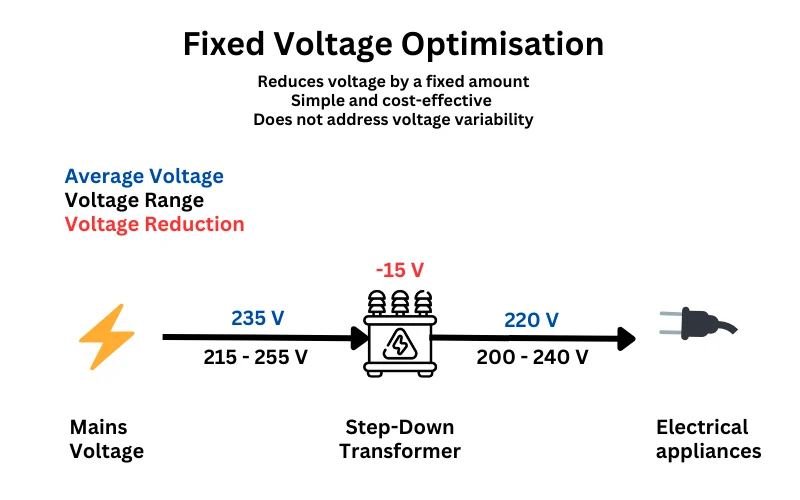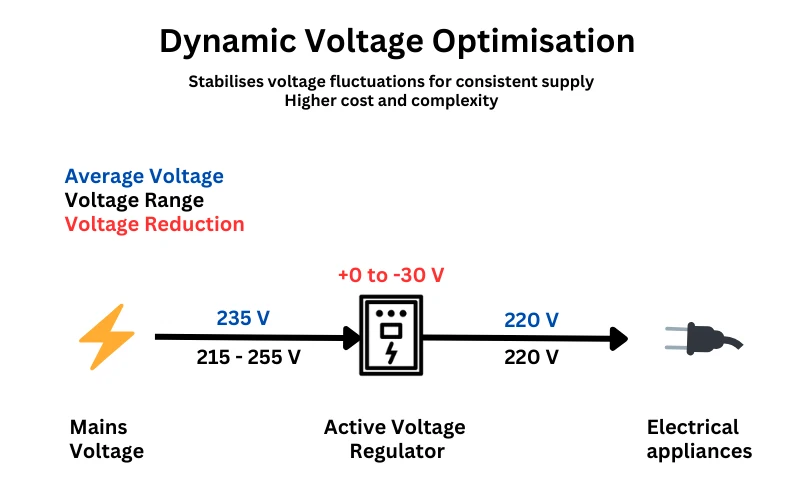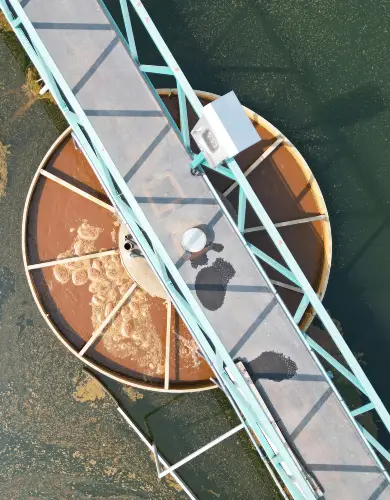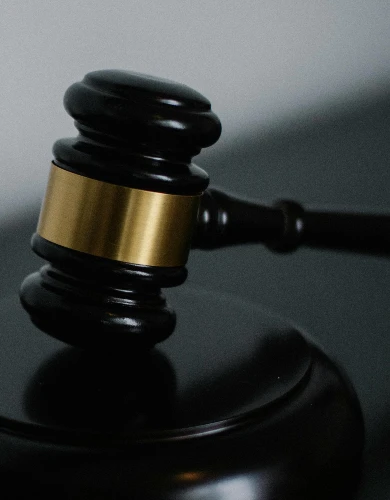Voltage optimisation systems for businesses
A carefully configured voltage optimisation system can improve the energy efficiency of a commercial property by up to 10%, reducing both energy bills and carbon emissions.
In this guide, we explain how a voltage optimisation system works when installed at a commercial property. We provide business owners with the information needed to assess whether implementing a voltage optimisation system is a worthwhile investment.
Here’s what we cover:
- What is voltage optimisation?
- How does voltage optimisation work?
- Types of voltage optimisation systems for businesses
- How to assess if your business needs voltage optimisation
- The business case for voltage optimisation
- Cost of a commercial voltage optimisation system
- Implementation of a commercial voltage optimisation system
What is voltage optimisation?
Voltage optimisation is a technology used to regulate and reduce the voltage of a building’s electricity supply. It works by lowering the voltage of the incoming electricity to an optimal level for the electrical appliances and devices in use.
In Britain, a business energy connection provides a nominal voltage of 230V, with variability ranging between 220V and 250V.
Many business appliances operate most efficiently and achieve the longest lifespan at around 220V.
Optimisation systems help to reduce wasted energy and improve the lifespan of equipment and machinery by lowering and stabilising the voltage.
How does voltage optimisation work?
Voltage optimisation systems are typically installed at the incoming mains supply point after a business energy meter, ensuring that all downstream equipment benefits.
There are two main devices used in a voltage optimisation system to reduce and stabilise voltage:
- Step-down transformer – A device that uses electromagnetic induction to adjust the voltage levels of a power supply. The transformer is configured to step down the supplied voltage to an optimal level.
- Electronic voltage regulator – An electronic device that dynamically monitors and adjusts the voltage in a power supply. A voltage regulator can respond quickly to fluctuations in the mains supply voltage.
Types of voltage optimisation systems for businesses
There are two types of voltage optimisation technologies designed for commercial properties in Britain:
Fixed voltage optimisation

Fixed voltage optimisation is the simplest and most cost-effective type of voltage optimisation.
A step-down transformer reduces the voltage of a mains connection by a fixed proportion, which is optimal for the equipment at a specific commercial property.
However, fixed voltage optimisation only reduces the voltage of a power supply; it does not stabilise voltage variability.
Dynamic voltage optimisation

A dynamic voltage optimisation system uses an active voltage regulator to respond to fluctuations in the incoming supply, producing a stable output power supply at a precise voltage level.
Dynamic voltage optimisation ensures a consistent and predictable power supply to your devices.
How to assess if your business needs voltage optimisation
For businesses considering the installation of a voltage optimisation system, we recommend conducting a professional business energy audit that assesses:
- Voltage survey – Measure the incoming voltage levels provided by your connection to the local distribution network and compare them to your equipment’s optimal operating voltage.
- Voltage stability – Measure the variability of incoming voltage over time and evaluate whether your equipment and machinery are sensitive to voltage fluctuations.
- Energy consumption assessment – Use existing business energy monitors to measure the energy consumption at each electrical supply point.
A professional energy auditor can recommend the appropriate type of voltage optimisation equipment for each electrical supply point.
The assessment will also estimate potential energy savings, enabling your business to calculate the payback period for installing a voltage optimisation system.
The business case for voltage optimisation
A well-designed voltage optimisation system can pay for itself through improved business energy efficiency and an extended lifespan for electrical equipment.
We summarise the key benefits of a commercial voltage optimisation system.
Reduced energy costs
Voltage optimisation systems can help reduce the business energy consumption of electrical appliances and devices by lowering the voltage of the incoming electricity supply.
Business energy tariffs are based on a unit business electricity price per kWh. A well-configured voltage optimisation system can reduce the number of kWh your business consumes by up to 10%.
Increased lifespan of electrical equipment
Voltage fluctuations and higher-than-optimal voltage levels can damage electrical appliances and devices, reducing their lifespans and increasing maintenance costs.
By reducing the voltage supplied to the building, voltage optimisation systems can help extend the lifespan of electrical equipment.
Improved power quality
Voltage optimisation systems can enhance the quality of the power supply, reducing the risk of power surges and dips that can damage sensitive equipment and disrupt operations.
Environmental benefits
The national grid in Britain relies on fossil fuels to generate electricity, which means that power provided by the grid has a significant carbon footprint.
By reducing energy consumption, voltage optimisation systems can help lower a business’s carbon footprint, aiding in the achievement of sustainability targets and reducing environmental impact.
Cost of a commercial voltage optimisation system
Installing a voltage optimisation system requires a significant initial investment, which can pay for itself through long-term savings.
Voltage optimisation system providers typically offer two options: outright purchases or financing plans that allow the system to be paid for over time.
This section explains three key factors that impact the cost of a commercial voltage optimisation system.
Single or three phase power supply
Domestic and small business properties typically have a single-phase power supply, whereas larger commercial properties use a higher-capacity three-phase power supply.
Three-phase voltage optimisation systems are more complex and, therefore, more expensive.
Type of voltage optimisation system
Fixed voltage optimisation systems are generally less expensive, whereas dynamic systems are more advanced and therefore more costly.
Commercial properties with extensive electrical networks often require more sophisticated voltage optimisation systems, which increases the overall cost.
Number of connections
Commercial properties with multiple electrical supply points (MPANs) will require separate voltage optimisation installations.
Each voltage optimisation system is customised to its connection’s specific load and voltage characteristics.
Implementation of a commercial voltage optimisation system
If your business has already conducted a survey to determine whether a voltage optimisation system would be beneficial at your property, here are the next steps:
Step 1: Planning and design
A voltage optimisation system provider will develop a detailed plan to integrate voltage optimisation into your electrical system.
The plan will specify the physical location of the voltage optimisation unit and its connection point within the existing electrical infrastructure.
Step 2: Installation
A certified electrical engineer will handle the installation of the voltage optimisation equipment.
The installation requires a temporary power shutdown at your property while the equipment is mounted and connected.
The voltage optimisation unit is integrated with existing control panels for performance tracking and diagnostics.
Step 3: Testing and commissioning
Once installed, the voltage optimisation system is thoroughly tested to ensure proper functionality.
The voltage output is measured for stability to confirm alignment with target levels. The system is typically calibrated based on real-time load conditions.
Issues when implementing voltage optimisation for your business
Here are a few hurdles to consider when deciding whether to implement a voltage optimisation system at your business.
The cost of implementing the technology
The initial cost of installing a voltage optimisation system can be high, which may deter some businesses from adopting it.
Additionally, voltage optimisation units have a typical lifespan of between 15 and 25 years but are not easily transferable between properties.
Investing in voltage optimisation equipment may not be suitable if your business plans to move premises.
Regular maintenance
Regular maintenance of voltage optimisation systems is necessary to ensure they continue to reduce voltage effectively and deliver expected energy savings.
Additionally, as the electrical equipment at your commercial premises is updated or changed, your voltage optimisation unit may require reconfiguration.
Technical issues
Voltage optimisation systems require careful installation and monitoring to operate effectively and efficiently. If the system is not correctly installed or maintained, it can result in electrical problems and safety hazards.
Installing a voltage optimisation unit must adhere to strict electrical safety regulations in the UK.
Other ways to save on business energy costs
At AquaSwitch, we specialise in helping businesses reduce their utility costs.
We hope this guide has helped you understand whether voltage optimisation technology could help your business lower energy costs.
In addition, we offer a simpler way to cut commercial electricity and business gas prices without requiring any upfront investment.
Use our business energy comparison service to find the most competitive tariffs on the market.

